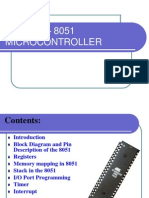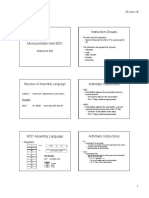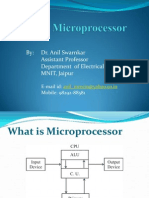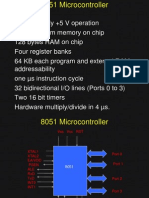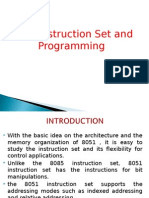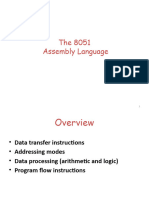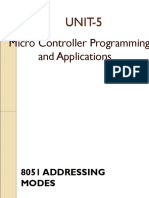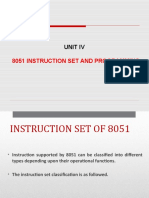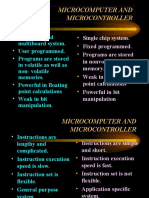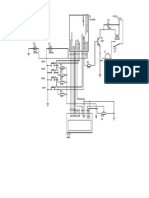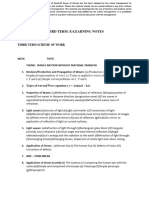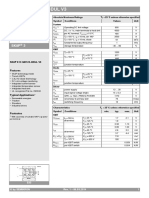8051 Micro Controllers
Introduction
Architecture
Signal Description
�What is a Micro controller
Its
a Microprocessor with integrated
peripherals
All peripherals are integrated in a single
chip
System cost is low
Size of system becomes small
Reliable than microprocessor based systems
Eternal memory ROM peripherals can be
integrated
Software security feature is available
40 pin 8 bit microcontroller has all this.
�Micro controller
microprocessor
�Difference of MC and MP
�differences
�INTEL 8051
40
PIN IC
Did not have a on chip EPROM
8751 was first MC with EPROM
8951 is 8051 + EEPROM
128
byte RAM
4kb ROM
4 , 8 bit I/o PORTS
2 timers 16 bit
UART- universal asynchronous remote
transceiver
�Architecture
�Architecture of 8051
ACC-
Accumulator
ACC or A, 8 bit
B-
reg
The reg is used to store one of the operands for multiply and
divide instructions.
PSW-
Program Status Word
Flags contain the status information and is considered as spl.
Fun. Reg.
Stack
Pointer SP-
8 bit reg, incremented before the data stored onto the stack
using the push or call.
After reset SP is initialized to 07H.
Here the stack pointer is incremented.
Data
Pointer: DTPR
16 bit reg contains a higher byte (DPH) and lower byte (DPL) of a
16 bit external RAM address.
�PORT
0-3 Latches & Drivers :
These four I/O ports- - P0, P1,P2,P3
Serial
Data Buffer (SBUF):
Two independent registers
One Transmit buffer PISO- parallel in serial out
Second Receive buffer- SIPO- serial in parallel out
Used for serial communication
Timer
Registers:
Two 16 bit timers accessed as lower and higher
order byte
TL0, TH0- timer 0
TL1, TH1- timer 1, lower and Higher respectively.
Control
Registers
Special function registers IP, IE,
TMOD,TCON,SCON,PCON contains status of
interrupt, timer/counter, serial port
�Timing
and control unit
Timing for the internal operation of the circuit.
Oscillator
Generating clock signals
Instruction
Reg:
Decodes the opcode for execution
EPROM
RAM
& Program address reg.
and RAM address register: 128 byte
ram
ALU:
Performs 8 Bit arithmetic and logical oerations
Special
Function Register bank:
Addressed using respective address - 80H to FF H
�Pin diagram
Vcc- 5V supply
Vss- Ground
RESET- resets 8051 if high for
2 machine cycles
ALE/PROG: - used if external
addressing is used. Else if
EPROM is used.
EA- external enable
PSEN- program store enable
PORT 0.0-0.7- Along with
address
PORT 1.0-1.7- 8 bit
bidirectional
PORT 2.0-2.7- along with
address
PORT 3.0-3.7
XTAL1,XTAL2Inbuilt oscillator and external
crystal pins
8051- 12MHz to 16Mhz freq.
��Registers
�RAM memory space allocation in
the 8051
14
�PSW (Program Status word) / Flag
Register
�Stack pointer (SP)
Stack pointer (SP) is an 8-bit register at address 81H.
It contains the address of the data item currently on
top of the stack.
Pushing increments SP before writing the data
(opposite to most microprocessors)
Popping
from the stack reads the data and
decrements the SP
8051 stack is kept in the internal RAM
Depending
on the initial value of the SP, stack can
have different sizes
Example:
MOV SP,#5FH
�Data Pointer
Data pointer (DPTR): is used to
access external data or code.
DPTR is a 16 bit register at
addresses 82H (low byte) and
83H (high byte).
The data pointer is used in
operations regarding external
RAM and some instructions
involving code memory.
�(I/O PORTS)PORT0, PORT1, PORT2, PORT3
One of the
most useful
features of the
8051 is four
bidirectional
I/O ports.
Each port also
has an output
drive and an
input buffer.
�Addressing Modes
There are 5 types of addressing
modes.
1.
2.
3.
4.
5.
Register addressing.
Direct addressing.
Register indirect addressing.
Immediate addressing.
Index addressing.
�Register Addressing Mode
In
register addressing mode; the source
and/or destination is a register.
In
this case; data is placed in any of the 8
registers(R0-R7); in instructions it is specified
with letter Rn (where n indicates 0 to 7).
1.
ADD A, Rn (This is general instruction).
2.
ADD A, R5 (This instruction will add the
contents of register R5 with the accumulator
contents).
�Direct Addressing Mode
In direct addressing mode; the
address of memory location
containing data to be read is
specified in instruction.
MOV A, 25H (This instruction will
read/move the data from
internal RAM address 25H and
store it in the accumulator.
�Register Indirect Addressing
Mode
In register indirect addressing
mode; the contents of the
designated register are used as a
pointer to memory.
MOV A,@R0 This instruction moves
the data from the register whose
address is in the R0 register into
the accumulator.
�Immediate Addressing
Mode
In immediate addressing mode, the
data is given with the instruction
itself.
MOV A, #47H (This instruction will
move the data 47H to accumulator.
# is used when ever you are moving a
data not for addresses.
�Index Addressing Mode
1.
Offset (from accumulator) is added to
the base index register( DPTR OR
Program Counter) to form the effective
address of the memory location.
MOVC A, @ A + DPTR ( This
instruction moves the data from the
memory to accumulator; whose
address is computed by adding the
contents of accumulator and DPTR)
�Instruction Set
1.
2.
3.
4.
5.
Data transfer instructions.
Arithmetic instructions.
Logical instructions.
Logical instructions with bits.
Branch instructions.
�Data Transfer Instructions
These
instructions move the
content of one register to another
one.
Data
can be transferred to stack
with the help of PUSH and POP
instructions.
�Data Transfer Instructions
MOV A, Rn
MOV A, direct
MOV A, @Reg indirect
MOV A, #data
MOV Rn, A
MOV Rn, direct
MOV Rn, #data
MOV direct, A
MOV direct, Rn
MOV direct, direct
MOV direct, @Ri
MOV direct, #data
MOV @Ri, A
MOV @Ri, direct
MOV @Ri, #data
�Arithmetic Instructions
ADD
8-bit addition between the accumulator (A) and a
second operand.
The result is always in the accumulator.
The CY flag is set/reset appropriately.
ADD A, # 34H
ADDC
8-bit addition between the accumulator, a second
operand and the previous value of the CY flag.
Useful for 16-bit addition in two steps.
The CY flag is set/reset appropriately.
ADDC A , Rx
28
�SUBB
Subtract with Borrow.
Subtract an operand and the previous value of
the borrow (carry) flag from the accumulator.
A A - <operand> - CY.
The result is always saved in the accumulator.
The CY flag is set/reset appropriately.
�Logical Instructions
ANL
/ ORL
Work on byte sized operands or the
CY flag.
ANL
ANL
ANL
ANL
ANL
ANL
A, Rn
A, direct
A, @Ri
A, #data
direct, A
direct, #data
�Logical Instructions
SWAP
RLA
RLC
RRA
RRC
�Branching Instructions
Compare and Jump if Not Equal
CJNE
Compare the magnitude of the two
operands and jump if they are not equal.
The values are considered to be unsigned.
The Carry flag is set / cleared appropriately.
32
CJNE
CJNE
CJNE
CJNE
A, direct, rel
A, #data, rel
Rn, #data, rel
@Ri, #data, rel
�Branching Instructions
Decrement and Jump if Not Zero DJNZ
Decrement the first operand by 1 and jump
to the location identified by the second
operand if the resulting value is not zero.
DJNZ Rn, rel
DJNZ direct, rel
No Operation
NOP
33








